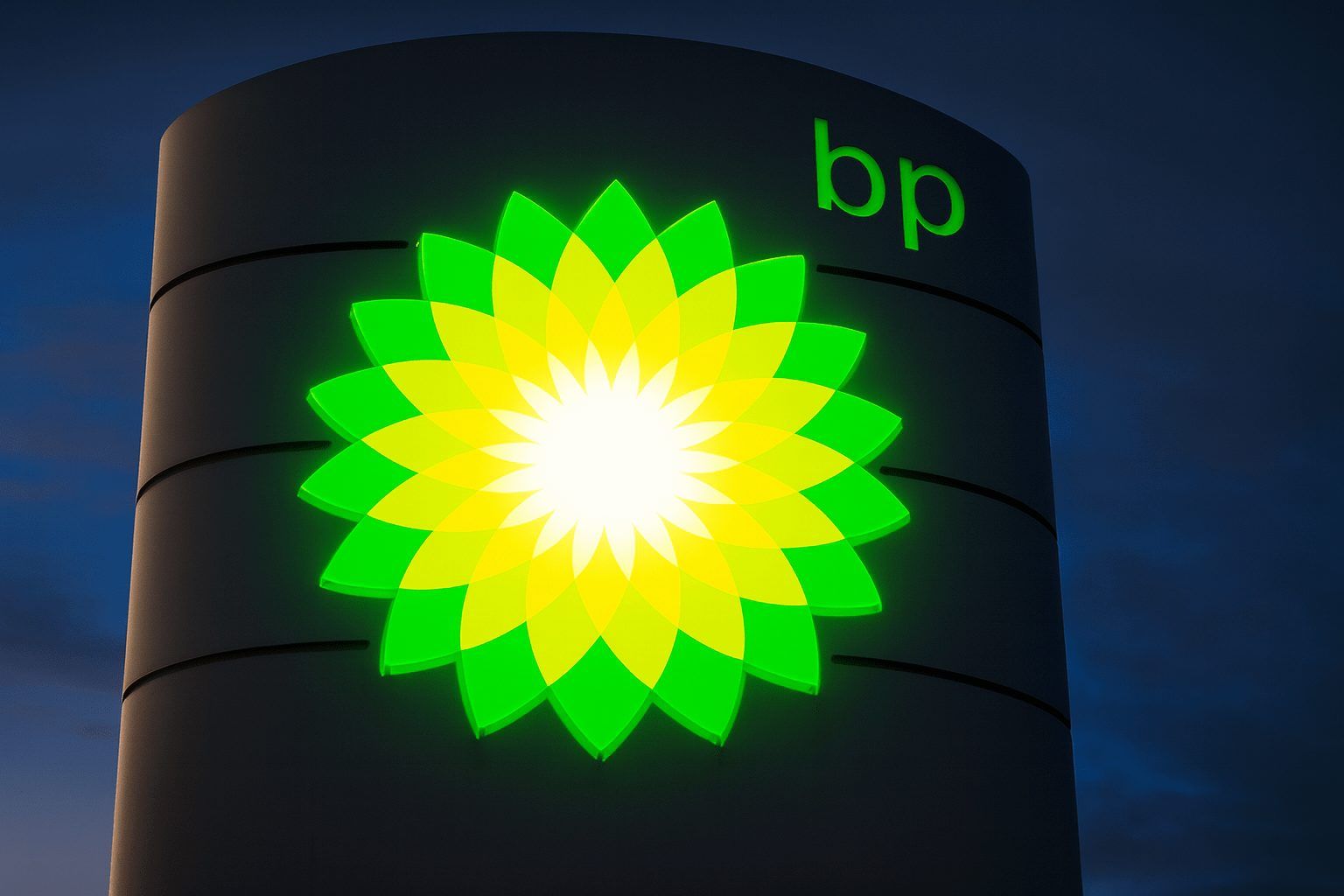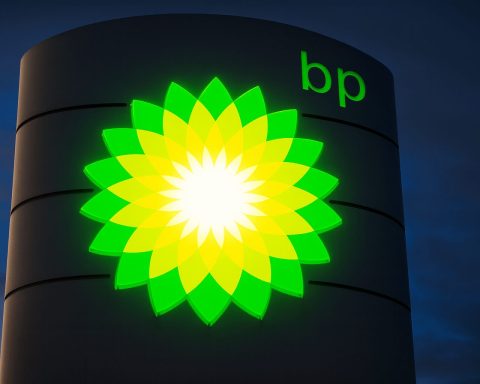Updated: November 23, 2025
BP p.l.c. (NYSE: BP; LSE: BP.) is trading near the top of its 52‑week range after a stronger‑than‑expected third quarter, a higher dividend, and another round of share buybacks. At the same time, investors are weighing a major strategic pivot back toward oil and gas, fresh growth projects, and new operational risks, including a pipeline leak in the U.S.
Here’s a detailed look at where BP stock stands today and what’s driving sentiment around the shares.
BP stock price today: near the top of its 52‑week range
As of the latest completed U.S. trading session on Friday, November 21, 2025, BP’s American depositary shares (ADSs) closed at $35.98, up about 0.7% on the day. The stock traded between $35.40 and $36.11 with volume of roughly 8.8 million shares. [1]
Over the past year, BP’s U.S. shares have moved between $25.23 and $37.64, putting the current price only about 4% below the 52‑week high. [2]
At this level, BP’s market capitalization sits around $91 billion and the stock’s forward price‑to‑earnings ratio is about 12, based on analysts’ earnings forecasts. [3]
In London, where BP’s ordinary shares trade under ticker BP., the stock recently closed around 458p, with a 52‑week range of roughly 329p to 476p and a one‑year price gain of about 17%, outpacing the broader FTSE 100. [4]
Q3 2025 earnings: beat expectations despite softer oil prices
BP’s latest leg higher has been supported by better‑than‑expected third‑quarter results, reported on November 4, 2025.
Key highlights:
- Underlying replacement cost (RC) profit for Q3 2025 came in at roughly $2.2 billion, slightly lower than a year ago but ahead of analyst expectations of around $2.0 billion. [5]
- On a per‑share basis, underlying RC profit was about $0.85 per ADS, beating the Wall Street consensus near $0.77 and improving on last year’s $0.83. [6]
- Operating cash flow reached $7.8 billion, up from the previous quarter, helped by working‑capital tailwinds and strong downstream performance. [7]
- Net debt remained roughly flat at around $26.1 billion, as robust cash generation was offset by bond redemptions and shareholder distributions. [8]
BP’s upstream oil and gas operations benefited from higher production and strong reliability, while its “customers and products” segment (refining, marketing and trading) saw better refining margins and lower turnaround activity, partially offset by weaker oil trading. [9]
Even though Brent crude prices were lower year‑on‑year, BP still managed to deliver earnings that broadly beat market forecasts, which has helped underpin the recent resilience of the share price. [10]
Dividends and buybacks: double‑digit shareholder yield
Income and value investors continue to focus on BP’s combination of dividends and share repurchases.
Dividend profile
For the third quarter, BP announced a dividend of 8.320 cents per ordinary share, equivalent to about $0.4992 per ADS, payable on December 19, 2025, to shareholders on the register as of November 14, 2025. [11]
On a trailing basis:
- BP’s annual dividend currently totals about $1.94 per ADS
- That implies a dividend yield of roughly 5.4% at the recent share price
- The company has grown its dividend for three consecutive years, with nearly 7% dividend growth over the last twelve months. [12]
BP’s management has reiterated a policy of increasing the dividend per ordinary share by at least 4% per year, subject to board approval and cash‑flow conditions. [13]
Aggressive share buybacks
Alongside the dividend, BP is also leaning heavily on share buybacks:
- A $750 million buyback program announced with Q2 results was completed on October 31, 2025. [14]
- With Q3 results, BP announced another $750 million of repurchases to be completed before the Q4 report. [15]
- London Stock Exchange filings show ongoing “transaction in own shares” notices as BP purchases shares in the market and transfers them into treasury. [16]
Data from independent trackers suggest that, combining dividends and buybacks, BP’s total shareholder yield is currently in the low double digits—around 11%. [17]
For investors, this means that much of BP’s investment case today is about cash returns as much as it is about earnings growth. Of course, yields at this level can fluctuate with both share price moves and future dividend decisions.
Strategy reset: pivot back toward oil and gas
A big driver of the BP story in 2025 has been a strategic shift away from an aggressive renewables build‑out and back toward traditional oil and gas.
Earlier this year, BP announced that it would:
- Increase annual oil and gas investment to about $10 billion,
- Scale back planned spending on renewables and low‑carbon projects by more than $5 billion, and
- Drop or dilute some of its longer‑term climate targets, including certain scope 3 emissions goals. [18]
BP now describes itself as an “integrated energy company”, but its spending priorities have clearly tilted back toward upstream projects and more traditional businesses such as lubricants. [19]
This reset has been shaped in part by activist investor pressure and by BP’s own analysis that the energy transition is proceeding more slowly than previously assumed, as outlined in its Energy Outlook 2025. [20]
The market’s initial reaction has been broadly positive. Commentary from major financial outlets notes that the strategy shift is expected to boost returns and cash flow compared with BP’s earlier, more capital‑intensive green strategy, though it also increases the company’s exposure to long‑term climate and policy risks. [21]
Growth projects and portfolio moves
Alongside the strategy reset, BP has announced a series of new projects, discoveries and asset sales that will shape its production profile and balance sheet over the next few years.
Major oil and gas discovery offshore Brazil
In August, BP reported its largest oil and gas discovery in more than 25 years, located in Brazil’s Santos Basin, in deep water about 400 km offshore. [22]
So far:
- Tests suggest a hydrocarbon column of around 500 meters
- It is BP’s tenth discovery in 2025, alongside finds in Egypt, Libya and the Gulf of Mexico
- The company sees the potential to lift production to 2.3–2.5 million barrels of oil equivalent per day by 2030, with room for further growth into the 2030s. [23]
The reservoir’s high CO₂ content will make development technically challenging and potentially more expensive, but it underscores how tightly BP is now tethered to large, long‑life fossil fuel projects.
Gas expansion in Egypt
In September, BP signed a preliminary deal with Egypt’s state‑owned EGAS to drill five new deepwater gas wells in the Mediterranean Sea, building on its long‑standing presence in the country. The wells are expected to tie back to existing West Nile Delta infrastructure and support Egypt’s efforts to reverse declining gas output. [24]
U.S. midstream asset sale
More recently, BP agreed to sell stakes in U.S. midstream assets to investment firm Sixth Street for about $1.5 billion, with roughly $1 billion paid at signing. The deal covers infrastructure in the Permian and Eagle Ford basins and forms part of a $20 billion divestment target by 2027 aimed at cutting net debt and simplifying the portfolio. [25]
These moves, combined with ongoing disposals such as a potential sale of the Castrol lubricants business, are intended to free up cash for higher‑return projects and for shareholder distributions.
Near‑term risk spotlight: Olympic Pipeline leak
Not all recent headlines have been positive. In November, BP shut down the 400‑mile Olympic Pipeline system in the Pacific Northwest after a fuel leak, temporarily halting deliveries of gasoline, diesel and jet fuel to parts of Washington and Oregon, including Seattle‑Tacoma International Airport. [26]
The company partially restarted one of the two lines before closing it again when monitoring showed elevated fuel levels at a collection point. Investigations and pipeline excavation are under way, and BP has not yet given a clear timeline for full repairs. [27]
While pipeline incidents are not unusual in the industry, they can increase regulatory scrutiny, lead to cleanup and remediation costs, and damage brand perception, particularly for a company still associated with past environmental disasters. Investors will be watching for updates on the operational and financial impact.
How the market views BP now: valuation and analyst sentiment
From a valuation perspective, BP sits in a somewhat unusual position:
- Because recent net income has been dampened by one‑off items, trailing earnings make the stock look expensive, with a very high backward‑looking P/E ratio. [28]
- On forward earnings, however, BP trades at around 12x projected profits, a discount to many large‑cap U.S. industrial and energy names. [29]
- Data from one market‑data aggregator shows a consensus “Hold” rating and an average analyst price target near $39.87, implying roughly 11% potential upside from the recent $35.98 share price, before dividends. [30]
Commentary in the financial press also notes that BP’s share price performance since mid‑year has outpaced several major peers, even as oil prices have softened, reflecting investor support for the company’s turnaround plan and capital‑return strategy. [31]
Key things for BP shareholders and watchers to monitor
Looking ahead from today’s snapshot (November 23, 2025), here are the main issues likely to influence BP’s share price:
- Execution on asset sales and net debt reduction
Progress toward the company’s target of $20 billion in divestments by 2027 and net debt of $14–18 billion will be a key marker of balance‑sheet strength and financial flexibility. [32] - Delivery of major upstream projects
The Brazil discovery, new wells in Egypt, and other 2025 project startups must translate into sustained production growth and competitive returns, not just headline reserve additions. [33] - Oil and gas price environment
BP’s earnings remain highly sensitive to crude and gas prices. Management has stressed that its turnaround plan is designed to be resilient even at lower prices, but commodity volatility will continue to drive quarterly results. [34] - Regulatory and climate‑policy risk
By scaling back some climate ambitions and doubling down on fossil fuels, BP may face greater scrutiny from regulators and ESG‑focused investors, which could affect its cost of capital and license to operate over time. [35] - Operational reliability and safety
Incidents like the Olympic Pipeline leak highlight the importance of safe operations. Any major accident or extended outage could quickly weigh on both earnings and sentiment. [36]
Bottom line
As of November 23, 2025, BP stock sits near its 52‑week highs, supported by a solid Q3 earnings beat, a rising dividend, and ongoing share buybacks that together deliver a double‑digit shareholder yield. At the same time, the company is taking on greater long‑term exposure to oil and gas, along with the regulatory and environmental risks that come with that pivot.
For investors following BP, the story today is less about dramatic short‑term catalysts and more about whether management can:
- Turn its revamped upstream portfolio and project pipeline into reliable cash flow,
- Continue shrinking net debt while rewarding shareholders generously, and
- Navigate the energy transition in a way that keeps BP investable for both traditional and ESG‑conscious capital.
As always, any decision to buy, hold, or sell BP stock should be based on your own objectives, risk tolerance, and independent research. This article is for information only and does not constitute investment advice.
References
1. markets.financialcontent.com, 2. stockanalysis.com, 3. stockanalysis.com, 4. www.hl.co.uk, 5. www.reuters.com, 6. www.nasdaq.com, 7. www.directorstalkinterviews.com, 8. www.directorstalkinterviews.com, 9. www.directorstalkinterviews.com, 10. www.reuters.com, 11. www.bp.com, 12. stockanalysis.com, 13. www.nasdaq.com, 14. www.bp.com, 15. www.directorstalkinterviews.com, 16. www.londonstockexchange.com, 17. stockanalysis.com, 18. www.reuters.com, 19. www.bp.com, 20. www.bp.com, 21. global.morningstar.com, 22. www.theguardian.com, 23. www.investopedia.com, 24. www.reuters.com, 25. www.wsj.com, 26. www.reuters.com, 27. www.reuters.com, 28. seekingalpha.com, 29. stockanalysis.com, 30. stockanalysis.com, 31. www.ft.com, 32. www.wsj.com, 33. www.investopedia.com, 34. www.ft.com, 35. www.aljazeera.com, 36. www.reuters.com










